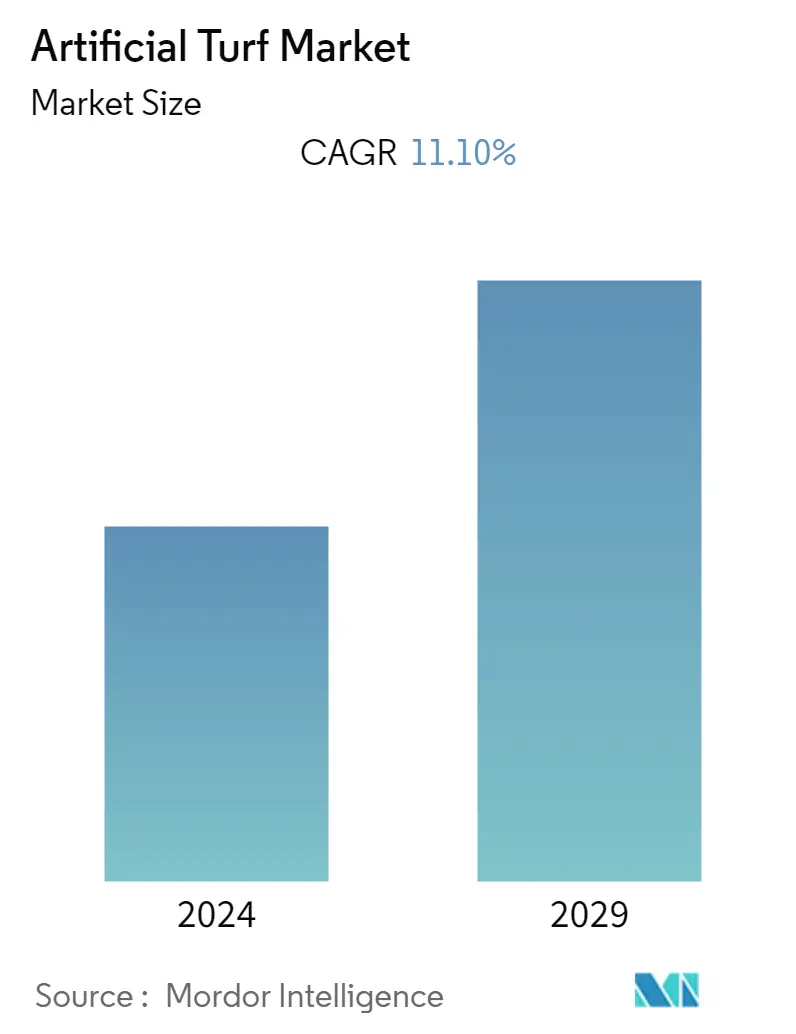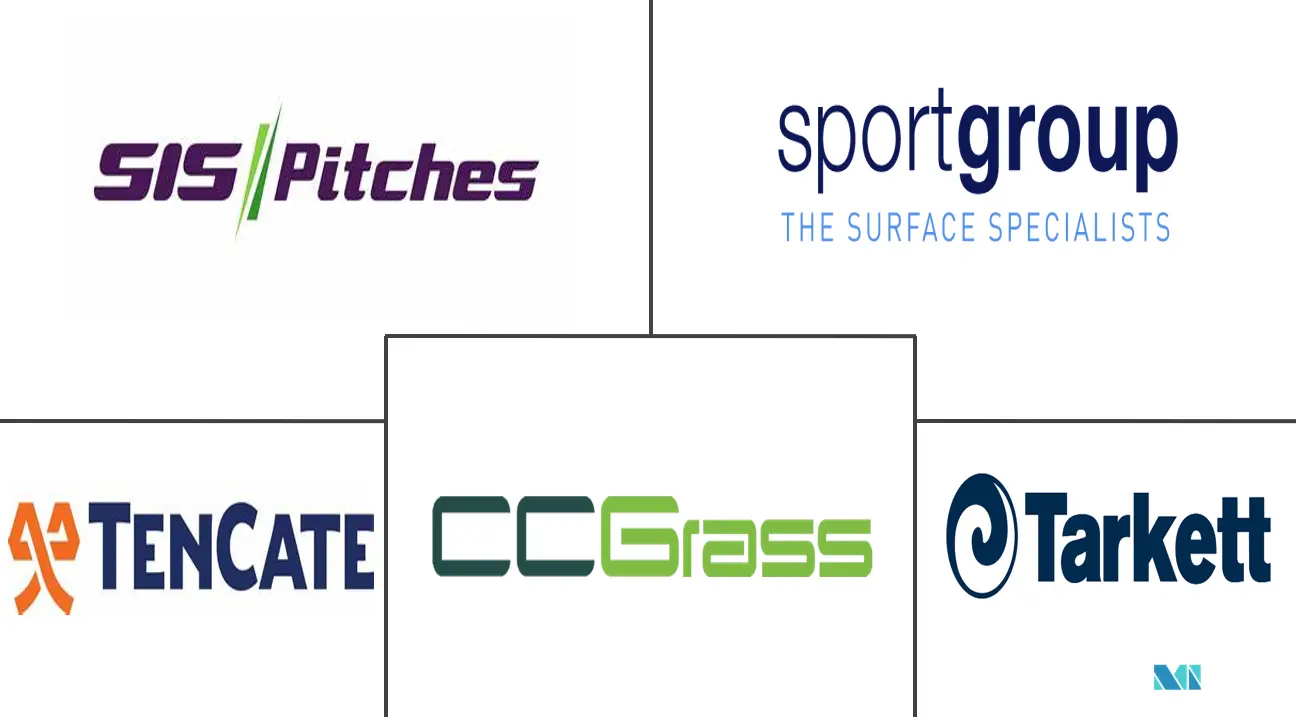Market Size of Artificial Turf Industry

| Study Period | 2019 - 2029 |
| Base Year For Estimation | 2023 |
| CAGR | 11.10 % |
| Fastest Growing Market | Asia-Pacific |
| Largest Market | Europe |
| Market Concentration | Low |
Major Players
*Disclaimer: Major Players sorted in no particular order |
Artificial Turf Market Analysis
The global artificial turf market is projected to register a CAGR of 11.1% over the next five years.
The use of turf in landscape applications is increasing and will likely create growth opportunities for the artificial turf market soon. Artificial turfs find the highest service in contact sports, such as soccer and rugby, two of the most popular games in and around Europe, thus contributing to the significant share held by the regional market. Many new artificial turfs are set up for soccer and rugby grounds, with the most notable development being the artificial turfs usage for the FIFA Women's World Cup and in the FIFA World Cup. To meet the growing demand from the sports and landscaping industries, manufacturers are placing a strong emphasis on creating third-generation turfs employing hybrid technology to develop innovative products with shock cushions and anti-bacterial features.
There is also high demand for artificial turf in the residential and commercial application sectors. With various advantages, artificial turf is a valid substitute for lawns. They are used in backyards, edgings, pavers, medians, and poolside areas to create commercial and residential playgrounds, focusing on children's safety. Artificial turf is simple to use, especially inside and outside. They will never break because they are UV-resistant and will function efficiently and comfortably for a very long period. Artificial grass is highly durable. It can be used for a very long time if maintained properly. Further, various developed and developing countries are experiencing rapid urbanization, leading to significant construction sector growth globally. Thereby fueling low-maintenance product demand, especially artificial turf.
The COVID-19 pandemic affected economies and industries in various countries. The unprecedented increase in COVID-19 cases and the subsequent lockdown of numerous manufacturing facilities influenced the growth of multiple markets. The distribution network was significantly disrupted in the Middle East and Africa, which affected artificial turf sales.
Artificial Turf Industry Segmentation
Artificial turf is a surface of synthetic fibers that looks like natural grass. It is often used in arenas for sports originally or commonly played on grass. However, it is now used for residential lawns and commercial applications. The global artificial turf market is segmented by usage and geography. Based on usage, the market is segmented into contact sports, field hockey, tennis, other sports, leisure, and landscape. The market is segmented based on geography: North America, Europe, Asia-Pacific, South America, Middle-East, and Africa. For each segment, the market sizing and forecasts have been done based on value (in USD million).
| By Usage | |
| Contact Sports | |
| Field Hockey | |
| Tennis | |
| Other Sports | |
| Leisure | |
| Landscape |
| By Geography | |||||||||
| |||||||||
| |||||||||
| |||||||||
| |||||||||
|
Artificial Turf Market Size Summary
The global artificial turf market is experiencing significant growth, driven by increasing applications in sports and landscaping. The demand for artificial turf is particularly strong in contact sports like soccer and rugby, which are popular in Europe, contributing to the region's substantial market share. The market is witnessing a shift towards third-generation turfs that incorporate hybrid technology, offering features such as shock cushions and anti-bacterial properties. This innovation is aimed at meeting the rising demand from both the sports and landscaping sectors. Additionally, the residential and commercial sectors are increasingly adopting artificial turf as a low-maintenance alternative to natural grass, benefiting from its durability and UV resistance. The rapid urbanization in developed and developing countries further fuels the demand for artificial turf, as it aligns with the growing construction activities worldwide.
The COVID-19 pandemic posed challenges to the artificial turf market, disrupting supply chains and affecting sales, particularly in the Middle East and Africa. However, the market is rebounding due to the resurgence of sporting events and government investments in infrastructure projects, including sports facilities and commercial gardens. The sports segment remains the largest market share holder, driven by the ease of maintenance and extended playing time offered by artificial turf. Europe continues to see rapid market expansion, supported by increased infrastructure spending and urbanization, with the United Kingdom and France leading in artificial turf installations. The competitive landscape is marked by key players like Tarkett Group, Tencate Grass, and CCGrass, who are focusing on product innovation and strategic expansions to meet consumer demands.
Artificial Turf Market Size - Table of Contents
-
1. MARKET DYNAMICS
-
1.1 Market Drivers
-
1.2 Market Restraints
-
1.3 Porter's Five Forces Analysis
-
1.3.1 Bargaining Power of Suppliers
-
1.3.2 Bargaining Power of Buyers/Consumers
-
1.3.3 Threat of New Entrants
-
1.3.4 Threat from Substitute Products
-
1.3.5 Intensity of Competitive Rivalry
-
-
-
2. MARKET SEGMENTATION
-
2.1 By Usage
-
2.1.1 Contact Sports
-
2.1.2 Field Hockey
-
2.1.3 Tennis
-
2.1.4 Other Sports
-
2.1.5 Leisure
-
2.1.6 Landscape
-
-
2.2 By Geography
-
2.2.1 North America
-
2.2.1.1 United States
-
2.2.1.2 Canada
-
2.2.1.3 Mexico
-
2.2.1.4 Rest of North America
-
-
2.2.2 Europe
-
2.2.2.1 Spain
-
2.2.2.2 United Kingdom
-
2.2.2.3 Germany
-
2.2.2.4 France
-
2.2.2.5 Italy
-
2.2.2.6 Russia
-
2.2.2.7 Rest of Europe
-
-
2.2.3 Asia-Pacific
-
2.2.3.1 China
-
2.2.3.2 Japan
-
2.2.3.3 India
-
2.2.3.4 Australia
-
2.2.3.5 Rest of Asia-Pacific
-
-
2.2.4 South America
-
2.2.4.1 Brazil
-
2.2.4.2 Argentina
-
2.2.4.3 Rest of South America
-
-
2.2.5 Middle-East and Africa
-
2.2.5.1 South Africa
-
2.2.5.2 Saudi Arabia
-
2.2.5.3 Rest of Middle-East and Africa
-
-
-
Artificial Turf Market Size FAQs
What is the current Artificial Turf Market size?
The Artificial Turf Market is projected to register a CAGR of 11.10% during the forecast period (2024-2029)
Who are the key players in Artificial Turf Market?
Tarkett Group, Tencate grass, CCGrass, SIS Pitches and Sports Group (Rekortan) are the major companies operating in the Artificial Turf Market.

